Museums Log More Visitors in 2021, but Much Fewer Than Before Pandemic
ZAGREB, 9 Feb 2022 - In 2021, the second pandemic year, Croatian museums logged 2,549,841 visitors, up 74% on 2020 but only 48% of the visits recorded before the pandemic, a survey by the Museum Documentation Centre shows.
The survey was conducted last month and covered 141 of Croatia's 164 public and private museums.
While many European museums were closed last year due to COVID, this was not the case in Croatia where the number of visitors was also a result of revived tourism last summer.
Almost 25% of the visitors registered last year visited the three usually most popular museums.
The Archaeological Museum of Istria in Pula saw 313,180 visitors, up 91% from 2020, but only 54% of the number logged before the pandemic.
The Split City Museum attracted 135,891 visitors, up 228% from 2020, but only 34% of the number before the pandemic.
Dubrovnik Museums had 111,411 visitors in 2021, up 166% from the year before, but only 37% of pre-pandemic figures.
Last year, as in 2019, foreign tourists accounted for almost 25% of museum visitors. Still, this only accounts for 42% of the visits generated before the pandemic.
Zagreb museums log sharpest fall in visitors due to earthquake, pandemic
The sharpest fall in visits was registered by Zagreb's museums, which have been closed since the March 2020 earthquake and are awaiting years-long reconstruction. The pandemic, too, reduced the number of visitors due to these various events.
Mimara, the Croatian Natural History Museum, the Strossmayer Gallery, and the Croatian School Museum had no visitors at all in 2021. The Croatian History Museum and the Archaeological Museum had between 1,000 and 1,500 visitors on other premises. The Museum of Arts and Crafts logged 15,182 visitors or 19% of the pre-pandemic number. The Klovićevi Dvori Gallery, typically the most visited venue, had 58,056 visitors, only 16% of figures compared to 2019.
The Vučedol Culture Museum in Vukovar registered 8,081 visitors, whereas in the years before the pandemic their numbers went up to 90,000.
The only category which saw a rise in 2021 in relation to 2019 were those who visited museums with a family ticket, with 120,726 registered in 2019, 57,749 in 2020 and 136,212 in 2021.
For more, check out our lifestyle section.
This Year's Museum Night to Take Place on 28 January
ZAGREB, 23 Jan 2022 - The 17th edition of Museum Night will take place on 28 January and this year's theme is "Museums between the real and the digital".
In light of the ongoing coronavirus pandemic, events will be held online and, where possible, offline with mandatory use of COVID passes.
The organizer, the Croatian Museum Association (HMD), said that cultural institutions were forced to adapt to the new reality, with most of the events being moved to digital communication channels.
All Museum Night programmes will be available via digital channels.
In the pre-pandemic years, Museum Night saw mass visits to museums, with the number of visits in one night exceeding 300,000. Last year, nearly all events were organized online.
The HMD organized the first Museum Night in 2005, with the participation of only a handful of museums in Zagreb. Since then, it has evolved into a national event, attracting 3,635,127 visitors. It takes place on the last Friday in January, from 6pm to 1am, and admission to museums is free.
For more on lifestyle, follow TCN's dedicated page.
From Vials to Valium, Rijeka's JGL Pharmacy Museum Is a Delight
January 23, 2022 - Visiting the JGL Pharmacy Museum in Rijeka, a modern cabinet of curiosities where vintage tablet-making machines meet the latest technology and elegant design
Tucked away in the Old town in Rijeka is one of the city’s most unique collections to discover. Explore the hissstory of pharmacy, says the snake on the wall, nudging us towards the entrance. Fear not - the snake is here as a symbol of health, rejuvenation and medicine, the mascot of the JGL Pharmacy Museum.
The specialised museum presents the history of pharmacy in a global context with a focus on Croatia and Rijeka in particular. Opened in October 2020, it was founded by the Croatian pharmaceutical company Jadran-Galenski laboratorij d.d. (hence the JGL in the name), whose vision is for the museum to become a reference institution in research of pharmacy history and a tourist attraction in Rijeka.
Based on what we’ve seen, it’s definitely an attraction. Albeit small, the permanent exhibit is a modern cabinet of curiosities where vintage tablet-making machines and hundreds of tiny vials and test tubes meet the latest technology and elegant design.
A wonderful garden of health (hortus sanitatis) featuring medicinal and other herbs covers the wall and guides you to the entrance:
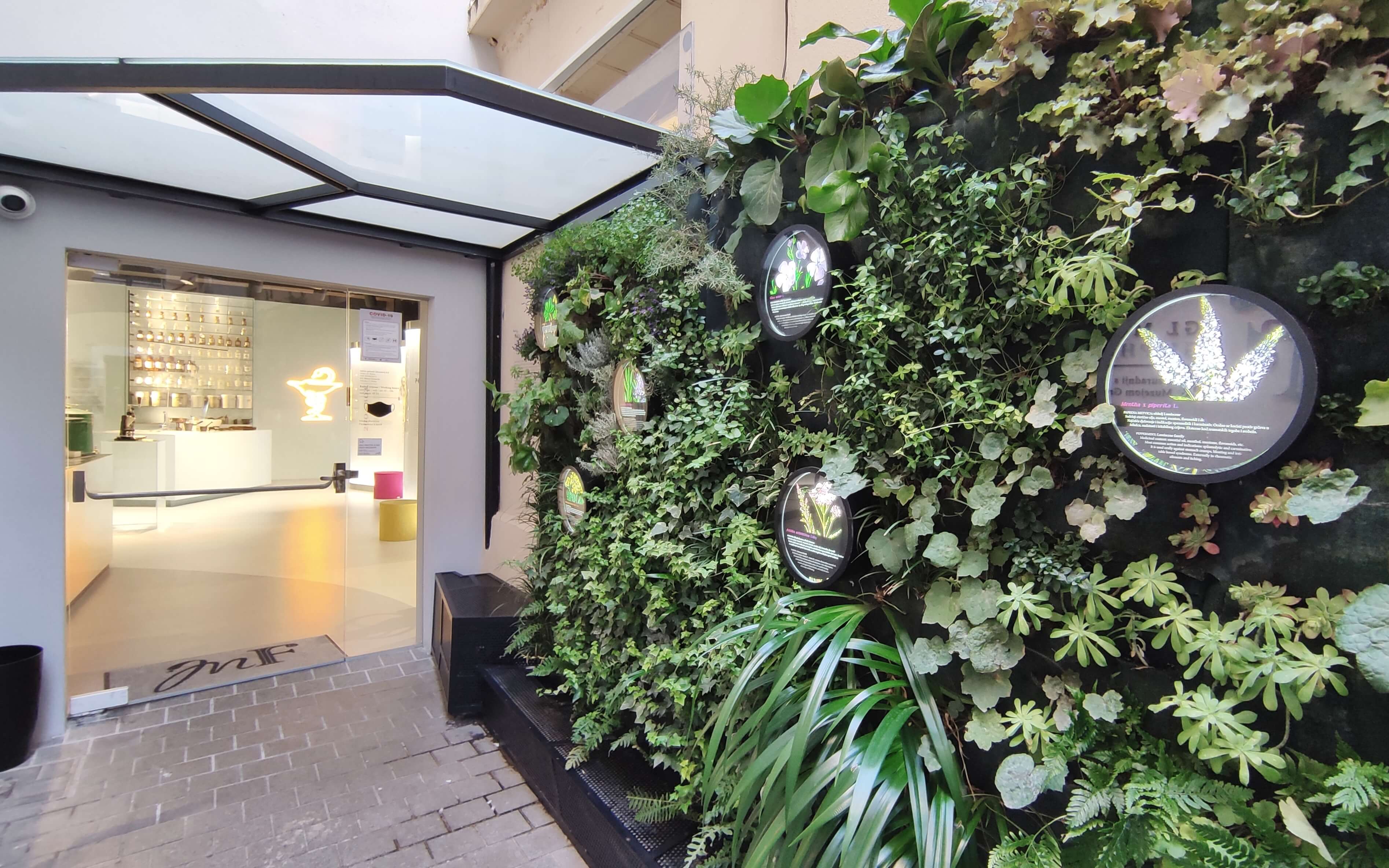
Inside, a sleek glass timeline snakes through the exhibition space and comes to life through AR, with distinguished individuals from the history of pharmacy telling their stories and teaching us a few interesting facts along the way.
You’d be perfectly fine just checking out the exhibits as the display is engaging enough as it is, but the AR points significantly add to the experience as they expand on the info presented on the panels, making the historical personalities more entertaining and lifelike - this will likely be a deciding factor if you’re visiting with kids. The AR guide is available in Croatian and English - pick up your tablet when purchasing tickets at the entrance.
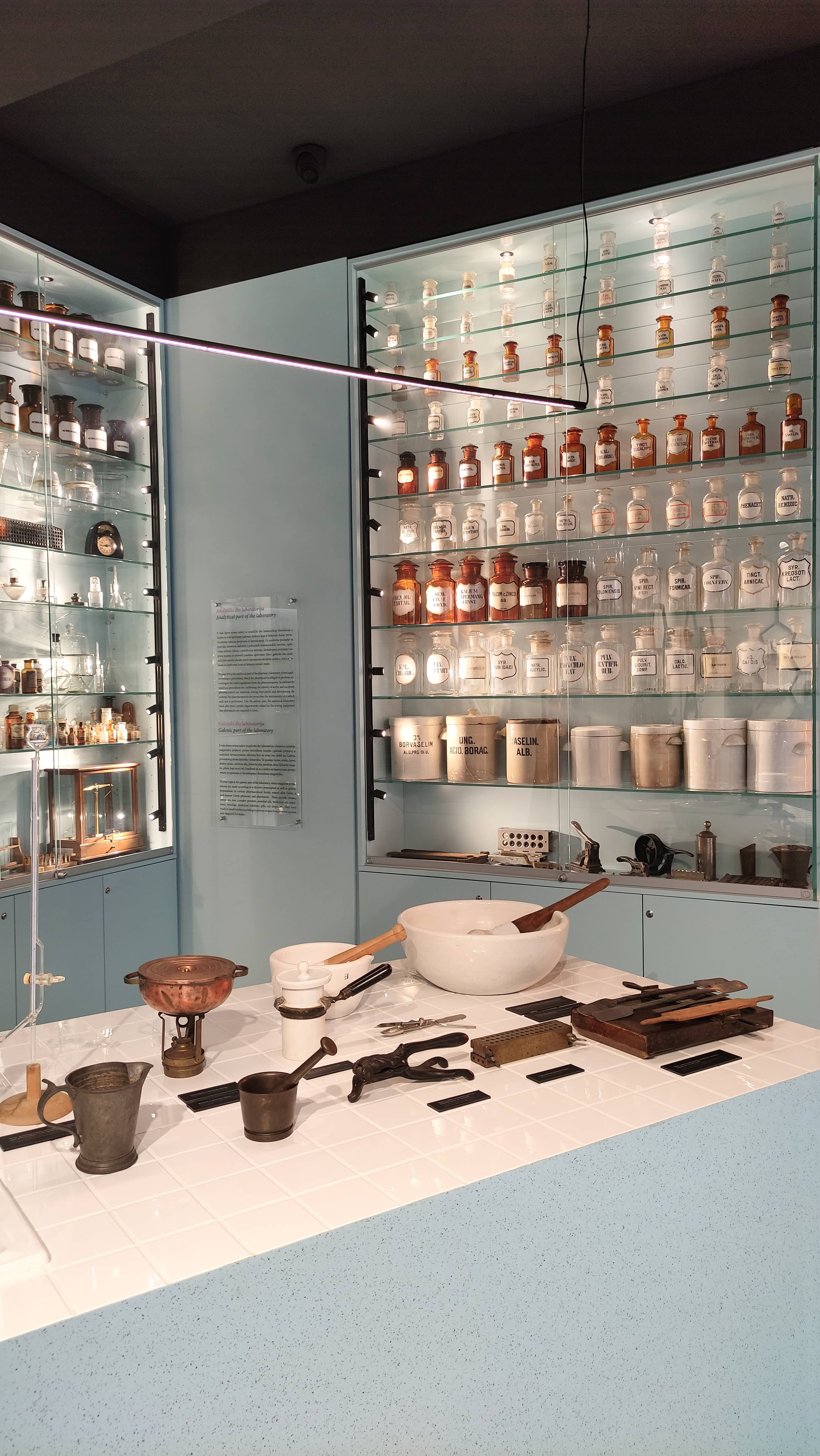
Here are a few things we learned to spark your curiosity:
- The inventor of diazepam was born in Opatija, Croatia! Chemist Leo Henryk Sternbach invented the medicine first marketed as Valium in the early 1960s, after he’d moved to the US where he worked for Hoffmann-La Roche. By the end of the 60s, Valium became the top-selling medicine in the US. Sternbach soon retired but didn’t rest on his laurels, instead going on to work at the lab and mentor students for another 30 years.
- The Dalmatian town of Trogir was home to the oldest pharmacy in Croatia; the establishment was specifically mentioned as a pharmacy in historical records as early as 1271!
- The first monastic pharmacy soon followed: the Friars Minor pharmacy in the Franciscan monastery in Dubrovnik was founded in 1317. The Croatian Ministry of Culture placed the Dubrovnik pharmacy on the list of intangible cultural heritage in 2019.
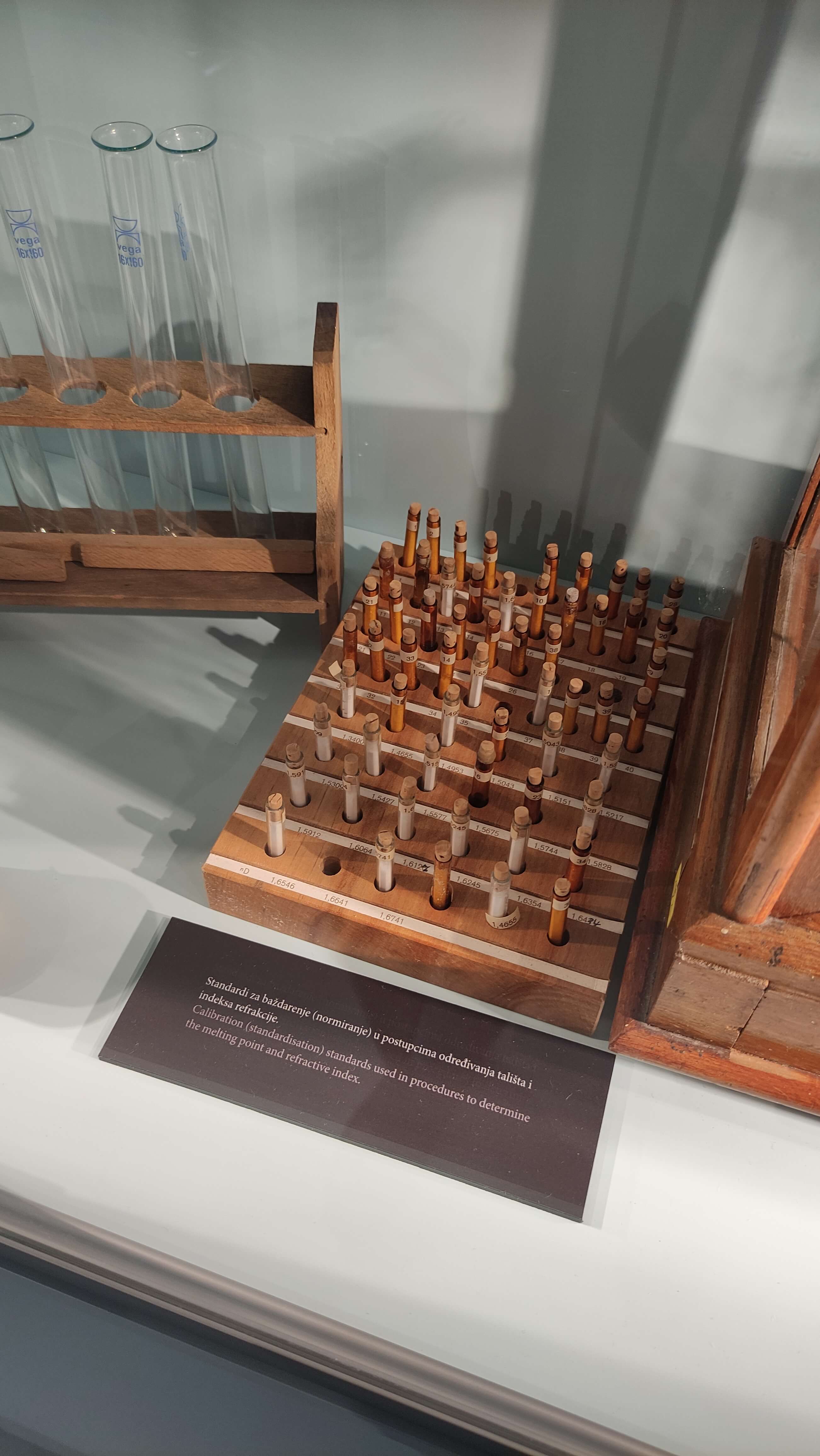
- Another nod to Dubrovnik as the first place in the world to introduce mandatory quarantine. In 1377, the Great Council of Dubrovnik passed a legislation that had all arrivals from areas ravaged by plague spend 30 days on Mrkan island before entering the city. (In comparison, today's isolation guidelines don't seem that harsh anymore.)
- Among the Nobel prize winners for chemistry are two Croats - a mentor and his protégé, Lavoslav Ružička and Vladimir Prelog. They were both involved in medicine development and won the Nobel prize in 1939 and 1975 respectively.
Hidden behind the timeline is the central exhibit, an impeccably recreated front-end space of a historic pharmacy (oficina) dating to the early 20th century.
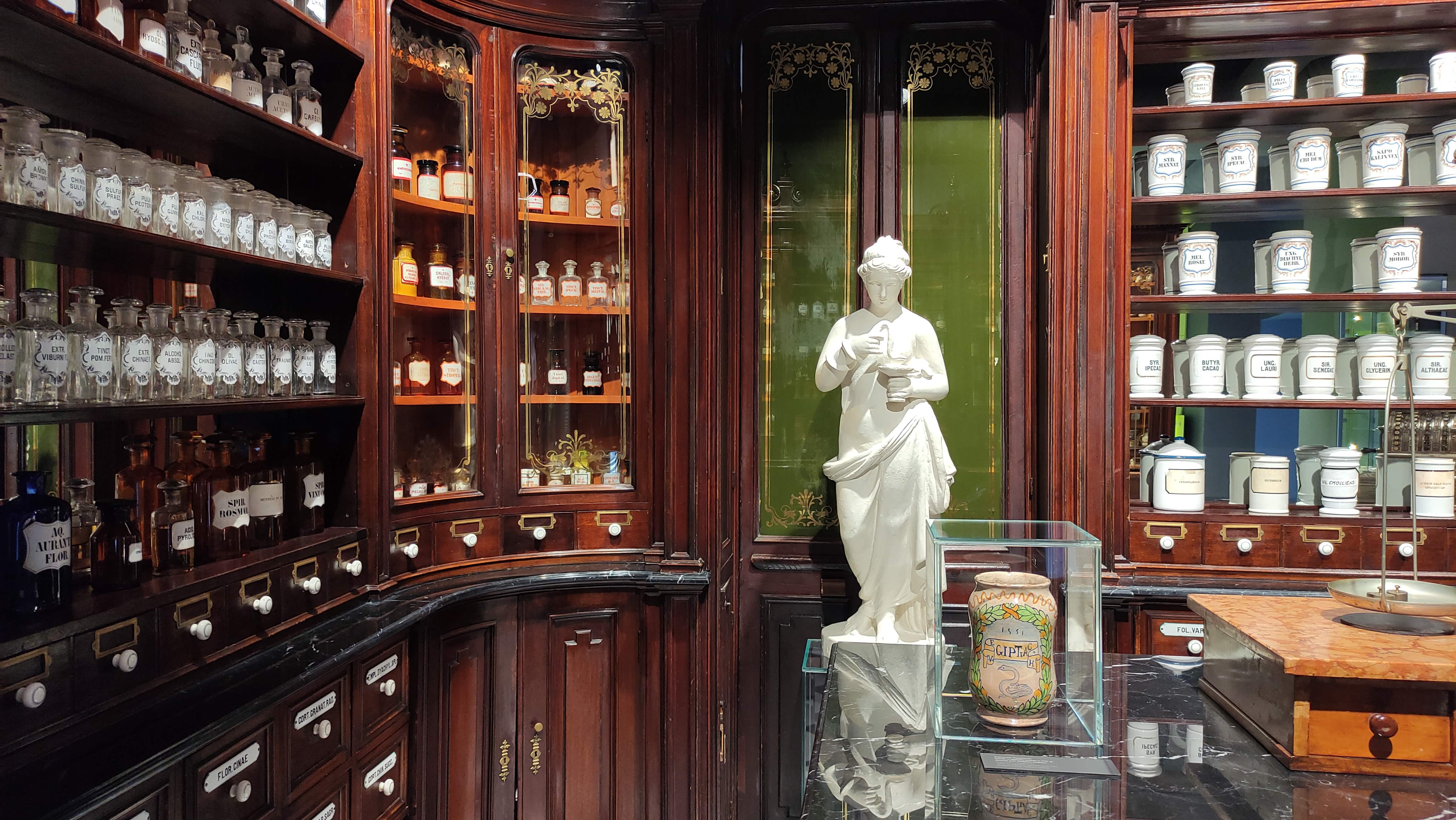
Front-end spaces were intended for the reception of patients, as well as preparation and dispensing of medicine. The one displayed here was in operation until 2019 in the pharmacy ‘Kolodvor’ near the railway station in Rijeka and comes complete with a pharmaceutical balance and a vintage cash register.
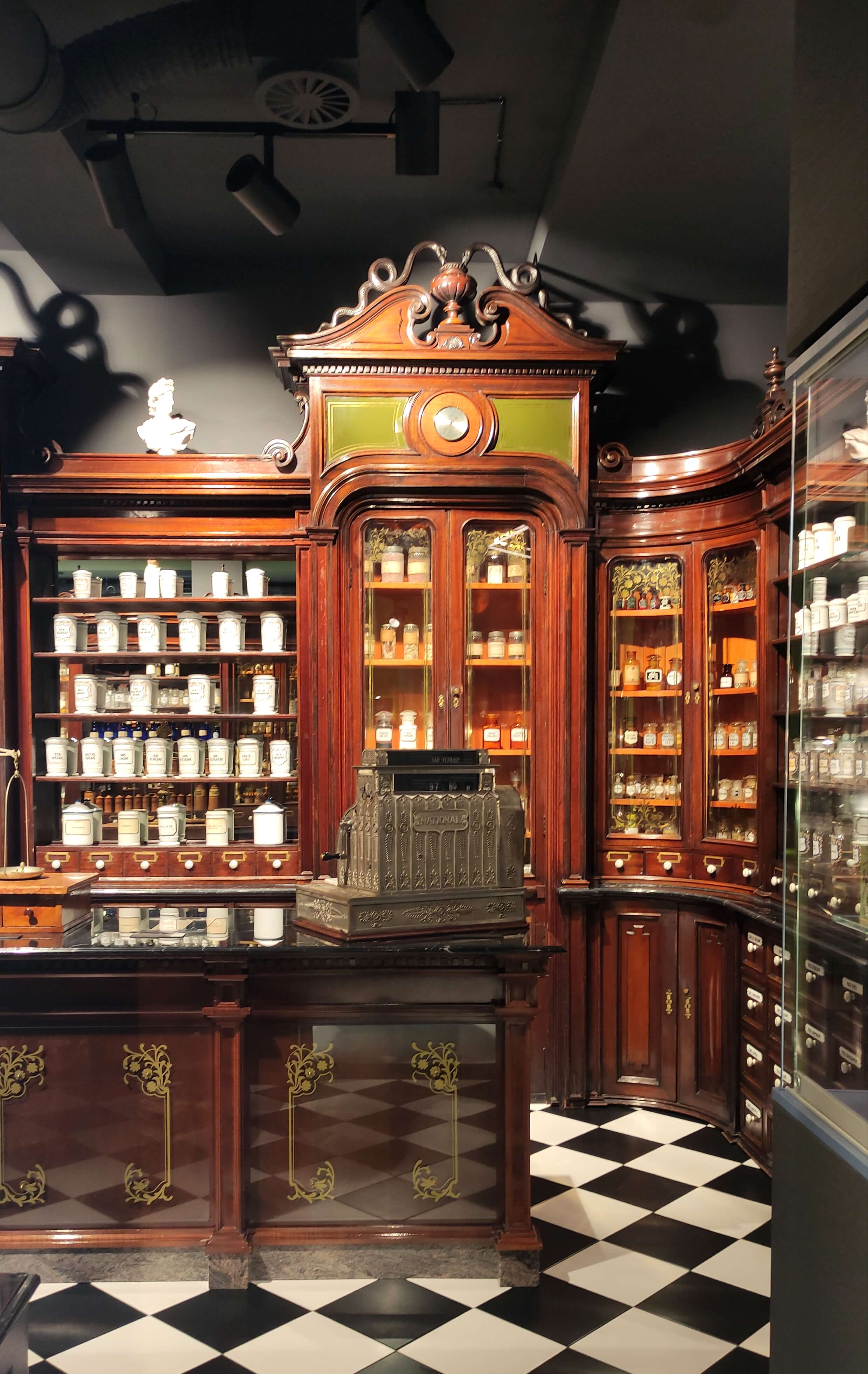
The exhibition gives us insight into local history as well, featuring two pharmaceutical companies from Rijeka, ‘Alga’ and ‘Ljekarna Jadran’. A pioneer not only in pharmaceuticals and cosmetics but in advertising as well, Alga was a marketing powerhouse and a household name in the interwar period. Their first product, named ‘Alga za masažu’ (massage algae), was made of natural extracts of native plants and was said to heal every malady from a toothache to influenza.
The ad below urges retailers to buy Alga in bulk and guarantees they’ll sell every single unit, or else they can return the unsold stock to the manufacturer:
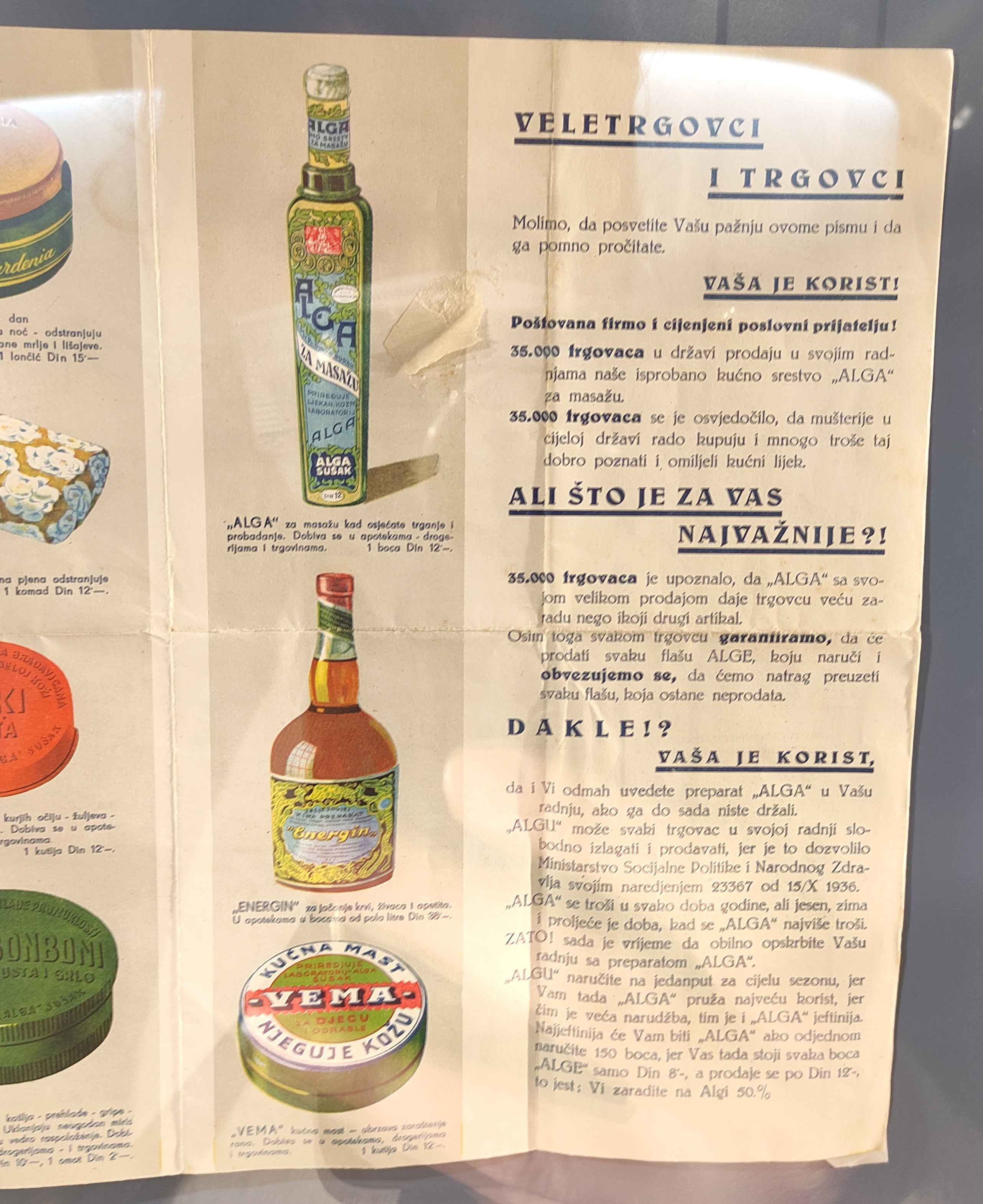
A section of the permanent exhibit is dedicated to medicinal herbs, including a modern twist on a herbarium and many cabinets and drawers to peek into:
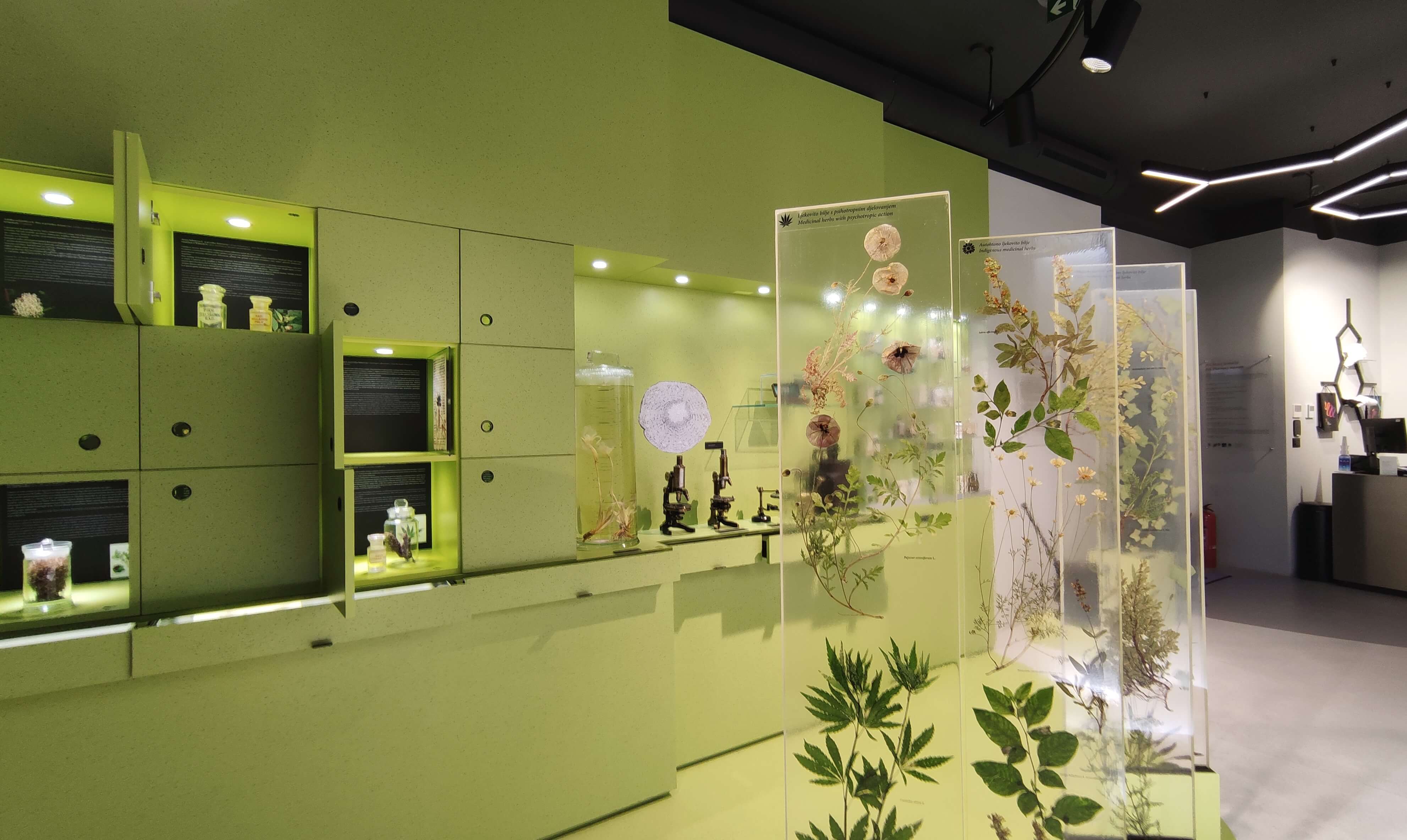
The entire display is superbly designed and allows the visitor to decide how much time and attention they want to dedicate to each exhibit; it doesn’t overwhelm with historical facts or scientific data, instead presenting information in an engaging and interactive way.
Indulge your obsession with historical curiosities and vintage bric-a-brac (just me?) and leave with a renewed appreciation for science. Overall, an excellent place to spend a Saturday afternoon.
Learn more about the JGL Pharmacy Museum on their website, and discover other attractions worth visiting in Rijeka in our guide here.
Croatia to Get Museum of Fake News
ZAGREB, October 4, 2020 - This month Croatia will get a Museum of Fake News, which in its first phase will operate as a website providing testimonies from journalists and scientists, a database of fake news, and tools for promoting media literacy and critical thinking and for recognising and fighting against fake news.
The project has been initiated by Lordan Prelog, a former journalist and editor and now a PhD student at the Faculty of Humanities and Social Sciences in Zagreb. He said that the project is also a contribution to the global fight against disinformation, which is a big threat to democracy and the development of open societies.
According to him, the most efficient way to fight against fake news is to further develop quality, responsible fact-based journalism and to raise public awareness of the dangers and spread of fake news.
He added that the Museum of Fake News project was a result of years of work of the Institute for New Media and E-democracy (InMed), the only Croatian association that is a member of the Social Observatory for Disinformation and Social Media Analysis (SOMA), one of the leading networks of institutions dealing with detecting fake news and models of its dissemination.
One of the most precise definitions of fake news is that is it the deliberate creation and sharing of fake and/or manipulated news with the intent to mislead the public and to do harm for political or personal reasons or for material gain, Prelog said.
He said his plan was to gather as many testimonies as possible from well-known journalists and other media experts who had come across disinformation in their work.
According to him, the term "disinformation" is much more precise than the neologism "fake news", which was popularised after the 2016 US presidential election by US president Donald Trump, known for false claims, conspiracy theories and vulgar insults.
The Museum of Fake News is not a commercial project, and in its initial phase it will consist of a website where all interested members of the public, especially young people, will be able to get information on the phenomenon of disinformation in Croatia and the world, he said.
He added that disinformation had a much greater reach than regular news and that there was no quick and effective strategy in the fight against fake news.
"There is no simple solution, it is necessary to work on developing citizens' critical thinking. The trust in the media and state institutions can be restored through professional and above all ethical practice of journalism and, of course, by developing media literacy across society," Prelog said.
For the latest travel info, bookmark our main travel info article, which is updated daily.
Read the Croatian Travel Update in your language - now available in 24 languages
Nikola Tesla Museum Opens for Individual Visits
ZAGREB, May 3, 2020 - The Nikola Tesla Technical Museum in Zagreb has recently announced that it will reopen to the public on Monday, 5 May, but only to a limited number of individual visits, with adherence to sanitary and social distancing measures.
The reopening of museums and galleries is in accordance with the government's decision for starting business and other activities in the conditions of the Covid-19 epidemic.
Until further notice, the museum will be open from 9 a.m. to 5 p.m. from Tuesday to Friday, and from 9 a.m. to 1 p.m. on Saturday. It will be closed on Sundays, holidays, and Mondays.
Group visits and visiting the mine inside the museum will not be possible until further notice. Lectures in the Planetarium and in Nikola Tesla's Demonstration Cabinet will not be held either.
Visitors must adhere to sanitary measures, which include disinfecting hands, maintaining the physical distance of two metres, and they are also forbidden from touching museum exhibits or other surfaces when it is not necessary.
The number of people who can be in the permanent exhibition area at the same time has been limited to no more than 45.
The museum noted that its building had not sustained major damage in the earthquake that had struck Zagreb and its environs on 22 March.
More museum news can be found in the Lifestyle section.
MUO Could Reopen to Public This Autumn
ZAGREB, April 27, 2020 - The Museum of Arts and Crafts (MUO) in Zagreb is one of the museums most affected by the March 22 earthquake, but despite that the museum will not cancel its anniversary plans for 2020, and if all goes well, it will reopen this autumn, says the museum's director, Miroslav Gašparović.
A little over two months ago, the MUO presented its new visual identity and opened parts of the new permanent exhibition on the occasion of its 140th anniversary, but all planned activities were soon put on hold due to the coronavirus pandemic and then made uncertain by the earthquake that damaged both the building and the collections.
Speaking in an interview with Hina, Gašparović said that these days were a confirmation of the old saying that history repeats itself - a month after the museum was opened in Praška Street in 1880 there was an earthquake, and it happened again a month and five days after the new parts of the permanent exhibition were opened in 2020.
"Despite the shocking start of the museum's history, eight years after the first earthquake a palace was built for it and the museum is still housed in it. That was the first building in Zagreb that was purposefully built as a museum space, and I hope that in eight years a full reconstruction of the museum will have been done, and that it will shine with new splendour," Gašparović noted.
The anniversary is not forgotten, and Gašparović believes that some projects planned for this year will still be carried out. One of those projects is publishing the first monograph dedicated to the museum's history.
Gašparović said that they have gained considerable insight into the damage to the building itself, and part of it is available for everyone to see via impressive aerial footage the museum published on its Facebook page.
Structural engineers and various expert committees have inspected the building multiple times, the roof has been filmed by a drone, and 3D scanning of the whole building is in progress, which will be extremely important when further steps are taken.
More museum news can be found in the Lifestyle section.
ICOM Calls on Governments and Institutions to Help Croatian Museums
ZAGREB, March 27, 2020 - The International Council of Museums has called on governments and institutions to help museums in Zagreb that have been damaged in the strongest earthquake that has hit the Croatian capital in the last 140 years.
Expressing its sympathy with all Croatians affected by the disaster, ICOM posted photographs of damaged museums, noting that the situation is additionally aggravated by the COVID-19 epidemic.
Most of the museums in the city centre have suffered damage during the earthquake and some of them are no longer statically safe, ICOM said, adding that both buildings and artworks were damaged.
"ICOM is working with its Croatian National Committee and the Regional Alliance of South East Europe to support Croatian colleagues in their efforts to assess the damage to local museums and to find the best way to support them in their reconstruction and repair efforts," it said.
"Taking into account the current sanitary situation at national and international levels, ICOM urges municipalities, the Croatian ministry of culture and international organizations to come together to help the Croatian population and museum professionals, gathering human, financial and technical resources to support them in this difficult moment," ICOM said.
More museum news can be found in the Lifestyle section.
Most of Zagreb's Museums Damaged by Earthquakes
ZAGREB, March 23, 2020 - Most Zagreb museums situated in the centre of the city have suffered damage during the earthquakes that have occurred in Zagreb since Sunday, however, the full extent of the damage is yet to be assessed.
The Museum of Arts and Crafts on Sunday published a photograph which testifies to the extensive consequences of the quake and most curators began reporting on Monday on the situation in each of their museums.
Matea Brstilo Rešetar, the director of the Croatian History Museum told Hina that their building is no longer statically safe.
The director of the Schools Museum, Štefka Batinić, has informed that the museum is extensively damaged and that the building has been defined as not fit for use. The Arts and Crafts Museum and the Law Faculty situated around the Croatian National Theatre have also incurred some damage.
As far as theatre buildings are concerned the worst off is the Komedija Theatre, which will require significant repair works.
It seems that the Croatian National Theatre building has survived without any major damage but it is still waiting to be assessed by statics experts. Another three downtown theatres experienced slight damage.
The building housing Hina's offices in central Zagreb was severely damaged in the earthquake on Sunday, but the agency will continue to provide all its services to its clients round the clock.
Also the building housing the Croatian Journalists' Society was damaged in the disaster.
More news about the earthquake can be found in the Lifestyle section.
Archaeological Museum of Istria Most Visited Museum in 2019
ZAGREB, March 1, 2020 -The Museum Documentation Centre (MDC) has published on its website that Croatian museums recorded more than 5.2 million visitors last year, the most visited being the Archaeological Museum of Istria with 575,294 visitors.
Of the 160 museums from the Register of Public and Private Museums, 134 took part in the survey conducted by the MDC, together with 12 more museums from the Register of Museums, Galleries and Collections in Croatia
Data show that out of 5,235,765 visitors, which was 211,116 fewer than in 2018, 29.6% of them visited state museums.
After the Archaeological Museum of Istria, the most visited was the Split City Museum with 389,814 visitors, while the Klovićevi Dvori Gallery was third with 353,262 visitors, mostly because is situated in Zagreb's Upper Town where many events took place.
According to the analysis done by MDC director Maja Kocijan, museums boasting Croatia's best-known ancient monuments traditionally attract the largest number of visitors.
Permanent collections saw the biggest increase in the number of visits, by 200,000 compared with 2018, to which contributed an increase of 160,000 in the number of foreign tourists.
Temporary exhibitions saw the biggest decline, from 1,193,435 to 752,002 visitors.
What is most concerning, however, is the continuous decrease in the number of people taking part in educational programmes, which was 264,739 in 2016, but then dropped by 51.5% in just three years, Kocijan said, adding that the number of children and youth in museums is also continuing to slightly decrease.
Museum Night and International Museum Day saw a decline in the number of visitors in 2019 - Museum Night from 216,000 in 2018 to 169,314 in 2019, and International Museum Day from 16,771 in 2018 to last year's 15,940.
"Visitor statistics is a mirror of our attitude towards those we work for, but also, on the one hand, a very accurate basis for reflecting on the institutions' priorities, and on the other hand a solid basis for talks with founders," Kocijan underscored.
More news about museums can be found in the Lifestyle section.
15th Museum Night to Take Place on January 31
ZAGREB, January 13, 2020 - More than 200 museums, galleries, libraries, archives, educational institutions and organisations from Croatia and neighbouring countries will participate in the 15th anniversary of Museum Night on 31 January, with this year's theme being anniversaries, the Croatian Museum Society said on Monday.
All the institutions participating in the event will be open to visitors from 6 pm until 1 am in an effort to raise awareness about the importance of "museum past, present and future," the event's organisers said on their website.
Over the past fifteen years, hundreds of thousands of people have participated in Museum Night and one of the most significant achievements of the event is that it has attracted a new audience because so many people "discovered" museums on Museum Night and later became regular visitors.
"The 15th Museum Night in a row is another opportunity for museum workers and others to offer the public various experiences, including museum collections, expert, scientific, educational and entertaining content, virtual tours of museums, historical buildings and protected heritage sites, and the application of digital technology, which has opened unimaginable opportunities of inspiration, interpretation and presentation of museum content," said the organisers of Museum Night, Vesna Jurić Bulatović and Dubravka Osrečki Jakelić.
More news about museums can be found in the Lifestyle section.


